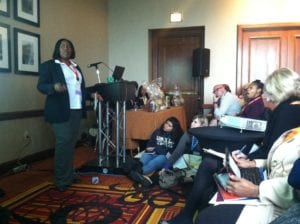#EdTrust2014 Conference — Day One
Heard Around Conference
FINAL UPDATE 6:20 p.m.
Project-Based Learning: It’s not about dioramas
Leaders from Charles R. Drew Public Charter School, one of the winners of this year’s Dispelling the Myth Award, explained how they are using project-based learning to accelerate learning and achievement in their classrooms.
First, it’s important to remember that project-based learning goes beyond student projects; students should be engaged in in-depth inquiry and then authentically applying that learning, said leaders from Drew Charter. Student projects there have ranged from making African masks to building remote-controlled lawnmowers, and each one has been pegged to rigorous standards.
“Critical thinking takes students from simply succeeding to exceeding expectations,” said a third-grade teacher at Drew Charter.
– Hilary Tackie
Helping Teachers Make the Grade in High-Need Schools
Three veteran school leaders moved an audience of educators with real-life stories about their methods for recruiting and retaining strong teachers and the best ways of translating their talents into actual academic results for high-need kids. One principal rallied interest in his school using the strength of the athletics program. Another resurrected and shaped a teaching team out of the ruins of Hurricane Katrina. A third leader had a true open-door policy and sought to service kids’ high expectations for their own instruction.
At Jack Britt High School, Conrad Lopes focuses on the importance of having a vision of what kind of teachers you want in your school.” Proud of the team she’s assembled, Mary Haynes-Smith tells the staff of New Orleans’ Bethune Elementary, “I want to show the world you all.” And former Principal June Eressy is skeptical of “the perception that if you just change your staff, you’ll change your outcomes.” She believes that you have to create a space where people want to be.
These leaders know that it takes vision, courage, persistence, and creativity — in other words, inspired leadership — to foster a learning environment that attracts and retains strong teachers, who in turn perpetuate a climate and culture of high achievement.
– Anneliese Bruner
It Takes a School: Working together to get all students to graduation day
The staff and administration at Elmont Memorial High School just outside Queens, N.Y., collaborate across teams and disciplines in dynamic, targeted ways, to record graduation rates that far surpass state averages for students overall as well as for African American students and low-income students. Speaking to a packed room, they shared some of what makes their school succeed:
“I hold my counselors to very high standards. I tell them, you may be the difference between a student getting a high school diploma.” – Caron Cox, chairperson of pupil personnel services, Elmont Memorial High School
“We have a saying around Elmont: ‘Not on our watch.’” – John Capozzi, principal, Elmont Memorial High School
“Before coming to this conference, I asked our teachers to tell me what makes us different. They said, ‘You will never hear around here that’s not my job.’” – Caron Cox
“I came through the ranks of Elmont, so you are not going to tell me how hard it is to teach these students. We teach whoever walks through that door. We get what we get. But whoever walks through these doors will be educated.” – John Capozzi
“Another thing that we do differently: We make sure each student has a plan for the future that they can be proud of when they walk across the graduation stage.” – Caron Cox
– Robin Harris Smiles
Rural Teachers Leading Improvement: Collaborating Across Schools
UPDATED 6:10 p.m.
Despite its remote location and enduring winters, rural Brimley Elementary is experiencing increasing enrollment. Some students travel up to one and a half hours by bus each way to attend this school that borders an American Indian reservation and is practically within eyeshot of Canada.
Brimley’s principal, Pete Routhier, and the school’s staff participate with other schools throughout the district on curriculum review teams (CRTs) at the intermediate school district level (21 throughout the state, three in the Upper Peninsula) to promote and share professional development activities for every discipline. What’s learned is brought back to Brimley and presented to other staff. As a small staff, they know that collaboration is critical to accessing the expertise that lies beyond their school walls.
And with a student population that is over half American Indian, the school must answer to a parent advisory committee that has the power to heavily influence the direction the school takes. The committee nudged Brimley to establish Ojibwe language and culture class, but it doesn’t ignore the complementary need for curricular rigor. History and culture are folded into social studies, but there is no push to “throw” culture into everything. And tribal parents have a sophisticated understanding that the opening of a new casino on the reservation, which offers good-paying jobs, should not derail the prioritization of educational attainment. They have used their new prosperity to build a community college that tribal members can attend gratis.
And while it is true that some job applicants withdraw their names from consideration upon learning just how remote Brimley is, the school’s collaboration model keeps it in touch with best practices outside its physical confines. That kind of adaptability surely contributes to Brimley’s top performance: All its student groups perform higher in math than the state. A Dispelling the Myth Award winner, Brimley proves its mettle.
– Anneliese Bruner
Developing Great Teaching: From responsible entry to advanced practice
UPDATED 5:50 p.m.
Deborah Loewenberg Ball, dean of the School of Education at the University of Michigan, closed out the first day of #EdTrust2014. In today’s third and final plenary session, Ball spoke about elevating the teaching profession through better evaluation, feedback, and support. Flip through the slides below or click on the title to view the full Storify.
Closing the Word Gap: Systematic Vocabulary for High-Poverty Schools
UPDATED 4:20 p.m.
The award-winning team at Bethune Elementary School in New Orleans is a crowd favorite at Ed Trust’s conference, and this year was no different. Teachers from the school, which won a Dispelling the Myth Award in 2010, shared their strategies and tools for “making vocabulary come alive” at every grade level, from kindergarten to sixth grade. They included games, interactives, graphic organizers, Promethean boards, and other hands-on strategies.

The session with Bethune Elementary was so packed, participants opted to sit on the floor. Photo by Mandy Zatynski
“With kids, you can’t stick to one way of teaching vocabulary,” said Sherice Walker, kindergarten teacher at Bethune Elementary, where all of the children qualify for free and reduced-lunch and the majority are African American.
One of her favorite ways to engage students? “I take their games and make them my own,” Sherice quipped. Take, for example, Hot Potato. Instead of tossing around a “hot” potato until the music stops, children each have a word on a piece of paper that they pronounce as they pass it along to their peers. When the music stops, Sherice calls on a student: Who has the word ‘grin’? When did you grin today? And she asks another student: What made you grin? And another: How do you grin?
She tried it this afternoon with some unsuspecting conference participants, who were packed in the standing-room-only space. Four of them had words taped to the bottom of their chairs, and they came up to model the Hot Potato game. When the music stopped, Sherice asked who had “delicious.”
What did you have that was delicious today?
“Chicken,” said the conference participant, who had just come from Ed Trust’s lunch plenary.
What’s another word for “delicious”?
“Yum!” said the participant (mindful of the fact that she was pretending to be a kindergartener).
Sherice turned toward another participant in the circle and asked, Based on her answers, what do you think “delicious” means?
“Scrumptious?” he asked and shrugged.
Scrumptious? You need to go to the first grade! Everyone in the room laughed.
Kidding aside, it’s a smart way to engage students with vocabulary and avoid the traditional methods of reciting and memorizing.
“You’ve got to be rigorous in content, but relevant in your approach,” Sherice reminded everyone.
Stemming the Slide: Lessons learned from effective summer programs
UPDATED 2:15 p.m.
We’ve all heard of the summer slide. During the summer months, students’ learning declines, requiring educators to spend one to two months in the fall getting kids ready to learn again. Researchers call it the “faucet theory:” Learning resources are turned on during the school year for all youth, but the faucet is turned off during the summer, especially for low-income youth.
Enter Read to Succeed, a summer learning program implemented in Baltimore City Public schools. For five weeks in the summer, 4,000-plus students (85 percent of them are struggling readers) spend their mornings getting as much — if not more — reading instruction as they do during the school year. And in the afternoons, they participate in enrichment activities, reading for the 100 Book Challenge, learning how to play fairly, going on field trips, etc. Students also get lunch and dinner!
Anne Lilly, program evaluator, shared the data on the program’s success. Read to Succeed students saw learning gains across first, second, and third grades. And, when compared with similar students who didn’t participate, they experienced significantly less summer learning loss.
Monica Logan with the National Summer Learning Association called Read to Succeed the Cadillac of summer learning programs. But, for those with resource constraints, she says there are small things educators can do to stem the summer slide. For more on what those things are and what makes an effective summer learning program, visit www.summerlearning.org.
– Robin Harris Smiles
Leading the Way: Putting new standards in place
UPDATED 1:20 p.m.
Over lunch, conference attendees listened to a conversation between district administrators, who are working to implement college- and career-ready standards. With Ed Trust’s Sonja Santelises, Susan Bunting of Indian River School District and Susana Cordova of Denver Public Schools spoke candidly about the challenges they’re facing at every level and how they’re working toward success. And Catherine Lhamon, assistant secretary for civil rights at the U.S. Department of Education, began the discussion by sharing heart-breaking examples of inequities in classrooms across the nation. Flip through the slideshow below to see snippets of the conversation shared on social media or click on the title to see the full Storify.











